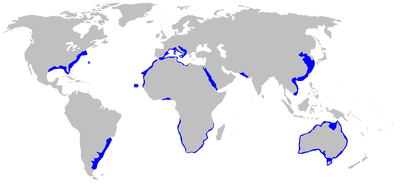- Sand tiger shark
-
Sand tiger shark 
Conservation status Scientific classification Kingdom: Animalia Phylum: Chordata Class: Chondrichthyes Subclass: Elasmobranchii Order: Lamniformes Family: Odontaspididae Genus: Carcharias Species: C. taurus Binomial name Carcharias taurus
Rafinesque, 1810The sand tiger shark or Grey nurse shark (Carcharias taurus) is a species of shark that inhabits coastal waters worldwide. It lives very close to the shorelines and beaches of North America, hence the name, sand tiger shark. Despite a fearsome appearance and strong swimming abilities, it is a relatively placid and slow moving animal. The sand tiger shark enjoys hunting in the surf of waters. This has caused many instances of accidental attacks upon humans.[1] It is the most widely kept shark in public aquariums around the world due to its large size and higher adaptability to captivity than other large sharks.[1]
Contents
Taxonomy
Scientific naming process
The sand tiger shark's scientific species name, Carcharias taurus, was originally determined by Rafinesque, a Turkish naturalist, after he had caught a specimen off the coast of the island Sicily. The scientific name for it has since undergone many disputes and changes. Twenty-seven years after Rafinesque's original naming, Müller and Henle, German biologists, changed the species' scientific name from C. taurus to C. triglochis.[2] The following year, the Swiss-American naturalist, Jean Louis Rodolphe Agassiz, introduced the name idea of Odontaspis cuspidata based upon examples of fossilized teeth. Agassiz's name was used for 120 years, only to cease in 1961 when three paleontologists and ichthyologists, W. Tucker, E.I. White, and N.B. Marshall, requested to repeal the Odontaspis cuspidate name. The experts' request for a name change from Odontaspis to Carcharias was rejected and Odontaspis won by default. However, experts realized that taurus belongs after Odontaspis. Therefore, the name was changed to Odontaspis taurus.[2] In 1977, a South African shark expert, Leonard J.V. Compagno, challenged the Odontaspis taurus name and substituted eugomphodus, a somewhat unknown classification, for taurus. However, many taxonomists and experts question his change saying that there is not a significant difference between Odontaspis and Carcharias. Also, experts argue that taurus should be used in place of eugomphodus because taurus is more commonly used and researched.[2]
The name was then reverted to back to its original determination by Rafinesque because of disagreements and fear of confusion. The final naming is still up for debate among shark experts.[2]
Description
Sand tigers have many features that distinguish them from other shark species. Their mouth extends beyond their eyes, and they usually swim with their mouth open. Their snout is flattened with a conical shape and their body is stout and rather bulky, with two large dorsal fins that are almost equal in size. The tail is elongated and has a long upper lobe, and the dorsal fins are set back almost beyond the pectoral fins and are broad-based.[3] The pectoral fins are triangular, and the tail is almost one-third as long as the head of the shark. The sand tiger shark's head is rather pointy, not round and the teeth are smooth edged and sharp-pointed. Also, juvenile sand tiger sharks have yellow-brown spots on their bodies. [4][5] The sand tiger shark usually has a grey back and white underside. It also has grey dorsal fins. The males also have a grey reproductive organ with a white tip. In August 2007, an albino specimen was photographed off South West Rocks, Australia.[6] The sand tiger sharks can grow to a maximum of 3.2 meters, but on average they range from 1.2 to 2.7 meters in length.[4]
Diet
The diet of the sand tiger shark consists of fish, young sharks and rays, squid, and crustaceans.[7]
Behaviour
Sand tiger sharks will often shelter in caves or gutters during the day, when they are more sluggish, and they become more active and feed at night. The sand tiger shark is the only known shark to gulp and store air in its stomach, which maintains the sharks' neutral buoyancy while swimming and allows them tp hunt motionlessly and quietly as not to alert their prey. [8][9] People normally associate the Sand tigers with the demeanor of being vicious because their teeth protrude from their mouths when their jaws are closed; however, they are generally not a danger for humans.[4]
Hunting strategies
Sand Tigers have a rather unique way of hunting for prey. They frequently go to the surface to gulp air. Their stomachs then store the air, allowing the shark to float slowly and lazily throughout the waters searching for prey.[1]
Habitat and Range
Sand tiger sharks usually live in sandy coastal waters, estuaries, shallow bays, and rocky or tropical reefs, at depths of up to 190 meters, although sand tiger sharks inhabiting even deeper depths have been recorded. There have been only three total reportings of sand tiger sharks in Canadian waters: in the Minas Basin of Nova Scotia; near St. Andrews, New Brunswick; and off Point Lepreau, New Brunswick. The sand tiger shark can be found in the Atlantic, Pacific and Indian Oceans, and also in the Mediterranean and Adriatic Seas. [4] [8]
In the Western Atlantic, the sand tiger shark is found in the coastal waters around the United States (from the Gulf of Maine to Florida), in the northern Gulf of Mexico around the Bahamas and Bermuda, and from southern Brazil to northern Argentina. The sand tiger shark is also found in the eastern Atlantic from the Mediterranean Sea to the Canary Islands, at the Cape Verde Islands, along the coasts of Senegal and Ghana, and from southern Nigeria to Cameroon. In the western Indian Ocean, the shark's habitat ranges from South Africa to southern Mozambique, but it does not live around Madagascar. The sand tiger shark has also been sighted in the Red Sea and may be found as far east as India. In the western Pacific, it has been sighted in the waters around the coasts of Japan and Australia, but not New Zealand.[10]
Reproduction
The sand tiger shark has one of the lowest reproduction rates of all species of sharks. The shark is easily affected by any population pressure.[9] The species practices adelphophagy, a form of viviparity where the embryos eat each other. Female sharks have two uteri. Inside each uterus the young sharks develop and eat from the yolk sac and then each other until there are only two left, one in each of the uteri. To provide further nourishment, the mother continues to produce eggs that are eaten by her two remaining young. After two years the young are around 1 m long, miniature replicas of their mother and fully able to fend for themselves and she gives birth to them in a lengthy labour.[11] There are reports of biologists probing the bellies of landed females and having their fingers nipped by the cannibalistic young with their fully developed teeth. The sharks are in the mother for approximately eight to nine months before they are delivered. Once they are born, it takes them 4–6 years to reach maturity.[12]
Conservation status
This species is listed as vulnerable on the IUCN Red List, and as endangered under Queensland's Nature Conservation Act 1992. It is a U.S. National Marine Fisheries Service Species of Concern. Species of Concern are those species about which the U.S. Government’s National Oceanic and Atmospheric Administration, National Marine Fisheries Service (NMFS), has some concerns regarding status and threats, but for which insufficient information is available to indicate a need to list the species under the U.S. Endangered Species Act.
References
- ^ a b c "Sand Tiger Shark". National Geographic. 2009. http://animals.nationalgeographic.com/animals/fish/sandtiger-shark.html?nav=FEATURES. Retrieved 2011-10-20.
- ^ a b c d "The Tangled Taxonomy of the Sandtiger Shark". ReefQuest Centre for Shark Research. 2007. http://elasmo-research.org/education/topics/ng_sandtiger_taxonomy.htm. Retrieved 2011-10-18.
- ^ "SAND TIGER SHARK". Florida Museum of Natural History. 2011. http://www.flmnh.ufl.edu/fish/gallery/descript/sandtiger/sandtiger.html. Retrieved 2011-11-21.
- ^ a b c d "Sand Tiger Shark". WebWise. http://www.new-brunswick.net/new-brunswick/sharks/species/sandtiger.html. Retrieved 2011-10-26.
- ^ "Sand shark Carcharias taurus Rafinesque 1810". UNITED STATES DEPARTMENT OF THE INTERIOR. 2009. http://www.gma.org/fogm/Carcharias_taurus.htm. Retrieved 2011-10-25.
- ^ "Rare albino shark rules deep". thetelegraph.com.au. 2007. http://www.news.com.au/dailytelegraph/story/0,22049,22204963-5007132,00.html. Retrieved 2008-08.
- ^ "Recovery plan for the Grey Nurse Shark (Carcharias taurus) in Australia". Australian Government: Department of Sustainability, Environment, Water, Population and Communities. 2002. http://www.deh.gov.au/coasts/publications/grey-nurse-plan/index.html. Retrieved 2011-10-18.
- ^ a b "Florida Museum of Natural History Ichthyology Department: Sand tiger Shark". Florida Museum of Natural History. 2009. http://www.flmnh.ufl.edu/fish/Gallery/DeSCRIPT/Sandtiger/Sandtiger.html. Retrieved 2011-10-18.
- ^ a b "Sand Tiger Shark". National Geographic Society. 2009. http://animals.nationalgeographic.com/animals/fish/sandtiger-shark.html. Retrieved 2011-10-26.
- ^ Pollard, D.; Smith, A. (2009), IUCN Red List of Threatened Species. Version 2011.2 Carcharias taurus, http://www.iucnredlist.org/apps/redlist/details/3854/0, retrieved 10 November 2011
- ^ Ross Piper|Piper, Ross (2007), Extraordinary Animals: An Encyclopedia of Curious and Unusual Animals, Greenwood Press.
- ^ "Sand Tiger Shark". New England Aquarium. http://www.neaq.org/animals_and_exhibits/animals/sand_tiger_sharks/index.php. Retrieved 2011-10-26.
Bibliography
External links
Categories:- IUCN Red List vulnerable species
- Odontaspididae
- Ovoviviparous fish
- Nature Conservation Act endangered biota
Wikimedia Foundation. 2010.


